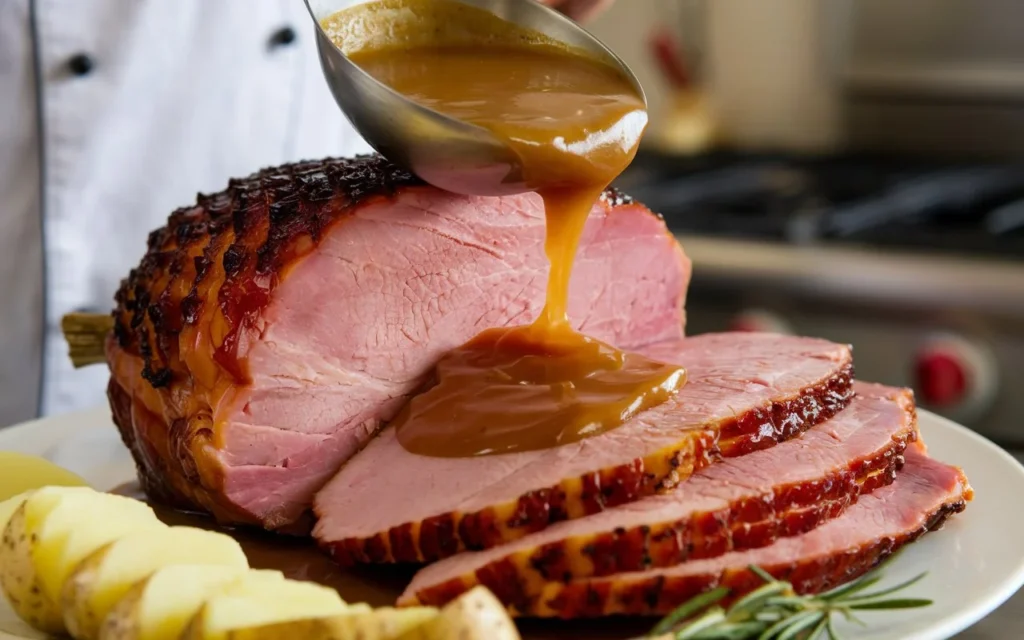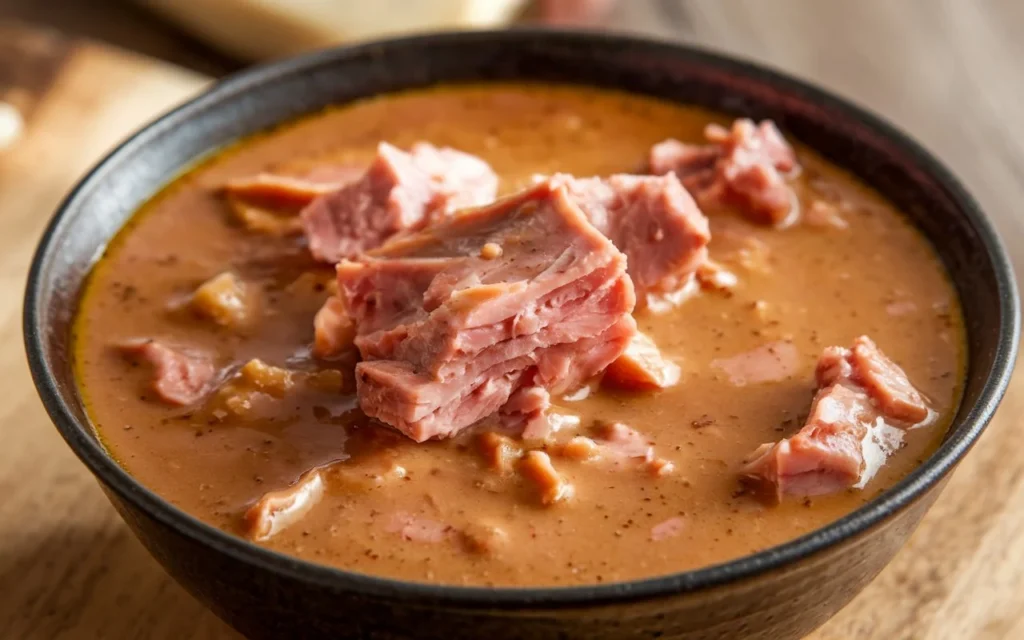Ham gravy is one of those comforting recipes that instantly takes a meal to the next level. Made from the rich drippings of cooked ham, it’s a versatile and flavorful addition to dishes like mashed potatoes, biscuits, or even grits. This guide is here to help you master the art of making ham gravy, whether you’re aiming for a classic version or exploring variations like creamy or gluten-free options. Along the way, you’ll discover helpful tips, serving suggestions, and solutions for common challenges. Let’s get started with everything you need to know about this savory favorite!
Introduction to Ham Gravy
What is Ham Gravy?
Ham gravy is a savory sauce crafted from the flavorful juices released when ham is cooked. These drippings are transformed into a luscious gravy by combining them with thickeners like flour or cornstarch and liquid bases such as broth or milk. It’s a timeless recipe, perfect for adding warmth and richness to various dishes, especially in Southern-style cooking.
From casual family dinners to festive gatherings, gravy serves as a delicious complement that ties meals together. Its versatility means you can customize it to your taste, making it a must-know recipe for any home cook.
Historical Background of Ham Gravy
The origins of gravy lie in the resourceful cooking traditions of the South. In the past, every part of a meal was used to create something nourishing and flavorful. Ham drippings became a key ingredient, evolving into the silky, savory sauce we enjoy today.
As time passed, ham gravy became a holiday staple, adorning tables during Thanksgiving, Christmas, and Easter. Its enduring appeal lies in its simplicity and the comforting, homemade touch it brings to any meal.
Next, we’ll explore the essential ingredients and step-by-step process to create the perfect ham gravy. Stay tuned!
Ingredients and Preparation
Crafting ham gravy begins with selecting the right ingredients and following a step-by-step process to achieve a rich, velvety texture. Each component plays a critical role, so understanding their significance ensures your gravy turns out perfectly every time.
Essential Ingredients for Ham Gravy
Ham Drippings: Sourcing and Significance
The cornerstone of any great gravy is the drippings—those flavorful juices left in the pan after cooking ham. These drippings carry the essence of the ham, with their salty, smoky profile forming the base of your gravy. To maximize their flavor, scrape the browned bits (fond) from the pan as these add depth and complexity.
Common Thickeners: Flour vs. Cornstarch
Choosing the right thickener is key. Flour is the traditional choice, creating a smooth, hearty texture. Cornstarch, on the other hand, offers a lighter finish and is an excellent gluten-free alternative. Whichever you choose, whisking thoroughly is crucial to avoid lumps.
Liquid Bases: Broth, Milk, or Cream
The liquid base you use can dramatically affect the flavor and consistency of your gravy. Chicken or vegetable broth adds a savory depth, while milk or cream introduces a rich, creamy element. For a balanced taste, consider combining broth with a splash of cream.
Seasonings: Salt, Pepper, and Optional Additions
While ham drippings are naturally salty, a dash of extra salt and freshly ground black pepper can enhance the flavor. Optional additions like garlic powder, onion powder, or a hint of thyme can elevate your gravy further, but keep it subtle to let the ham flavor shine.
Step-by-Step Preparation Guide

1. Collecting and Preparing Ham Drippings
After cooking the ham, pour the drippings into a heat-safe container to separate the fat from the juices. Allow the mixture to settle; the fat will rise to the top. Skim off the fat, leaving enough to coat the pan for making your roux.
2. Creating a Roux: Techniques and Tips
Heat the reserved fat in a skillet over medium heat. Add an equal amount of flour (typically two tablespoons of fat to two tablespoons of flour) and whisk continuously to form a smooth paste. Cook for about 1–2 minutes until the roux turns golden brown, releasing a nutty aroma. If using cornstarch, mix it with cold broth to form a slurry and add it later.
3. Incorporating Liquids for Desired Consistency
Gradually pour your chosen liquid base—broth, milk, or a mix—into the roux while whisking vigorously to prevent clumps. Start with one cup of liquid and add more as needed to reach your preferred consistency. Bring the mixture to a gentle simmer, allowing it to thicken.
4. Adjusting Flavors and Final Touches
Taste your gravy and adjust the seasoning. A pinch of salt and a grind of black pepper may be all it needs, but you can also add herbs or spices for extra flair. If the gravy becomes too thick, thin it with a bit more liquid; if it’s too thin, let it simmer longer to reduce.
With the basics of preparation covered, you’re now ready to explore creative variations and serving ideas. Up next: transforming gravy into a dish that’s uniquely yours!
Variations and Serving Suggestions for Ham Gravy
Ham gravy may be a classic dish, but its versatility allows for creative twists that cater to different tastes and dietary needs. From traditional Southern red-eye gravy to indulgent creamy versions, there’s a style for everyone. Plus, its adaptable nature makes it a fantastic companion to a wide range of meals, from hearty breakfasts to holiday feasts. Let’s dive into some popular variations and serving ideas to inspire your next culinary creation.
Popular Variations of Ham Gravy
1. Red-Eye Gravy: A Unique Twist on Ham Gravy
Red-eye gravy is a Southern classic steeped in tradition and bold flavors. This variation gets its name from the reddish sheen that forms on its surface due to the coffee used in the recipe. To make red-eye gravy, start by deglazing your skillet with freshly brewed black coffee immediately after cooking your ham. Stir vigorously to combine the coffee with the flavorful drippings, scraping up any browned bits.
This thin, tangy gravy is uniquely savory and pairs exceptionally well with biscuits, country ham, or fried eggs. The coffee’s slight bitterness enhances the salty richness of the drippings, creating a one-of-a-kind flavor. If you’ve never tried red-eye gravy, it’s a must for any lover of bold Southern cuisine.
2. Creamy Ham Gravy: Adding Dairy for a Richer Ham Gravy Experience
For those who prefer a luxurious, velvety texture, creamy ham gravy is an excellent choice. This variation swaps out traditional broth for milk, half-and-half, or heavy cream. Begin by preparing your roux as usual, then slowly whisk in the dairy of your choice, ensuring a lump-free consistency.
Creamy ham gravy has a softer, richer flavor that pairs wonderfully with buttery biscuits or roasted vegetables. It’s also a fantastic addition to casseroles, lending a smooth, indulgent touch to baked dishes. Whether you’re serving it at breakfast or dinner, this variation is a surefire crowd-pleaser.
3. Gluten-Free Options: Crafting Ham Gravy Without Flour
If you’re gluten-intolerant or prefer to avoid traditional flour, don’t worry—there are plenty of options to create a gluten-free gravy that’s just as satisfying. Cornstarch, arrowroot powder, and potato starch are popular alternatives. Instead of creating a traditional roux, you’ll make a slurry by mixing your chosen thickener with a bit of cold liquid (such as broth or milk).
Add the slurry to your hot ham drippings and whisk continuously to ensure smoothness. Gluten-free thickeners work quickly, so monitor the consistency closely to avoid over-thickening. This variation retains all the savory goodness of classic ham gravy, making it accessible to a wider audience.
Serving Suggestions for Ham Gravy
1. Pairing Ham Gravy with Biscuits, Mashed Potatoes, or Grits
Few things are as comforting as a warm, flaky biscuit smothered in ham gravy. The gravy’s rich, savory flavor complements the buttery, slightly sweet profile of biscuits, making it a staple pairing in Southern cuisine.
Ham gravy also shines when draped over creamy mashed potatoes, adding moisture and depth to the dish. For an authentic Southern breakfast, pour it generously over a bowl of grits. The creamy, slightly coarse texture of grits perfectly absorbs the gravy, creating a hearty and satisfying meal.
2. Incorporating Ham Gravy into Breakfast Dishes
Ham gravy isn’t just for dinnertime—it’s a breakfast superstar too! Use it to enhance classic breakfast staples like country ham, eggs, or hash browns. It works wonderfully as a topping for breakfast casseroles, adding an extra layer of flavor and moisture.
For a creative twist, consider serving gravy alongside savory breakfast pastries or using it as a dipping sauce for sausage or cheese scones. Its savory richness complements a wide range of morning flavors, making it an easy way to elevate your breakfast spread.
3. Enhancing Meals Beyond Breakfast with Ham Gravy
Ham gravy goes beyond breakfast and dinner to enhance nearly any meal with its savory profile. Drizzle it over roasted meats like turkey or chicken to add extra flavor and moisture. Spoon it onto baked potatoes for a decadent side dish, or stir it into cooked rice to create a savory, satisfying base for stir-fries or stews.
Ham gravy also works as a base for creative dishes like pot pies or casseroles. Use it to add creaminess to scalloped potatoes or as a flavorful layer in shepherd’s pie. Whether you’re cooking for a crowd or preparing a quick meal for yourself, this versatile gravy fits seamlessly into a variety of culinary contexts.
From bold red-eye gravy to indulgent creamy versions and versatile gluten-free options, there’s no shortage of ways to customize gravy to suit your tastes. Paired with a wide range of dishes, it’s a recipe that’s as flexible as it is delicious. Next, we’ll explore expert tips for perfecting your gravy, along with storage tips and answers to frequently asked questions. Stay tuned!ked questions. Stay tuned!
Tips, Storage, and FAQs
Crafting the perfect ham gravy doesn’t end with preparation—it’s all about refining your technique, storing it correctly, and knowing how to troubleshoot common issues. Let’s explore some expert tips, practical storage methods, and answers to frequently asked questions to make your gravy-making experience seamless and stress-free.
Expert Tips for Perfect Ham Gravy
1. Avoiding Lumps: Proper Whisking Techniques
Lumps in gravy are a common challenge, but they’re easily avoidable with the right technique. Always whisk continuously when adding flour or cornstarch to the pan. For best results, add liquids gradually and keep whisking vigorously to ensure a smooth, lump-free consistency. If lumps do form, use a fine mesh strainer or blend the gravy for a quick fix.
2. Achieving the Ideal Consistency in Ham Gravy
Getting the right consistency is key to a good gravy. If your gravy is too thin, let it simmer longer to reduce and thicken naturally. If it’s too thick, add small amounts of warm liquid (broth, milk, or cream) a little at a time while whisking until the desired consistency is reached.
3. Flavor Enhancements for Gravy: Herbs and Spices
While ham drippings bring plenty of flavor, you can elevate your gravy with subtle additions. A pinch of garlic powder, onion powder, or smoked paprika adds complexity. Fresh herbs like thyme, parsley, or rosemary lend a burst of freshness. Just be cautious not to overpower the natural flavors of the drippings.
Storage and Reheating Guidelines for Ham Gravy
1. Proper Storage Methods for Leftover Gravy
Allow your gravy to cool to room temperature before transferring it to an airtight container. Store it in the refrigerator for up to 3–4 days. To prevent a skin from forming on top, place plastic wrap directly on the surface before sealing the container.
2. Reheating Ham Gravy While Maintaining Quality
Reheat your gravy slowly over low heat, stirring frequently to maintain its smooth texture. If the gravy thickens during storage, add a small amount of broth or milk to loosen it while warming. Avoid overheating, as this can cause separation.
3. Shelf Life and Safety Considerations for Ham Gravy
Ham gravy is best consumed within a few days of preparation. If you’re unsure whether it’s still safe to eat, check for signs of spoilage, such as an off smell or discoloration. For longer storage, freezing is an option (details below).ff smell or discoloration. For longer storage, freezing is an option (details below).

FAQs About Ham Gravy
Can I make ham gravy without drippings?
Yes, you can! Substitute ham drippings with ham base or bouillon dissolved in hot water. This alternative still delivers a rich and savory flavor, making it a great option when drippings aren’t available.
How can I thicken ham gravy without flour?
Cornstarch, arrowroot powder, or potato starch are excellent substitutes for flour. To use, mix your chosen thickener with cold liquid to form a slurry, then whisk it into the hot gravy. This method creates a smooth texture while keeping the recipe gluten-free.
Is it possible to make ham gravy in advance?
Absolutely! Prepare your gravy ahead of time and store it in the refrigerator for up to 3 days. When ready to serve, reheat it gently on the stove, adding a splash of liquid to restore its consistency if needed.
What dishes pair well with ham gravy?
Ham gravy is a versatile companion to many dishes. It pairs wonderfully with mashed potatoes, biscuits, grits, roasted vegetables, and even baked chicken or turkey. Its savory richness complements a wide range of meals.
How do I fix lumpy gravy?
If your gravy develops lumps, don’t panic! Use a whisk to break them up or strain the gravy through a fine mesh sieve. For a quick fix, a handheld blender can smooth out the texture effortlessly.
Can I freeze leftover ham gravy?
Yes, ham gravy freezes well. Let it cool completely, then transfer it to a freezer-safe container, leaving some room for expansion. Freeze for up to 3 months. When reheating, thaw it in the refrigerator overnight and warm it slowly, stirring often to restore its smooth consistency.
Conclusion
Ham gravy is more than just a sauce—it’s a flavorful staple that adds warmth and richness to countless meals. From traditional recipes to creative variations, this versatile dish allows you to explore endless culinary possibilities.
Whether you’re perfecting a creamy version, experimenting with red-eye gravy, or serving it alongside classic pairings like biscuits and mashed potatoes, ham gravy is a recipe worth mastering. So, grab your whisk, gather your ingredients, and dive into the delicious world of homemade gravy. Your taste buds will thank you!








